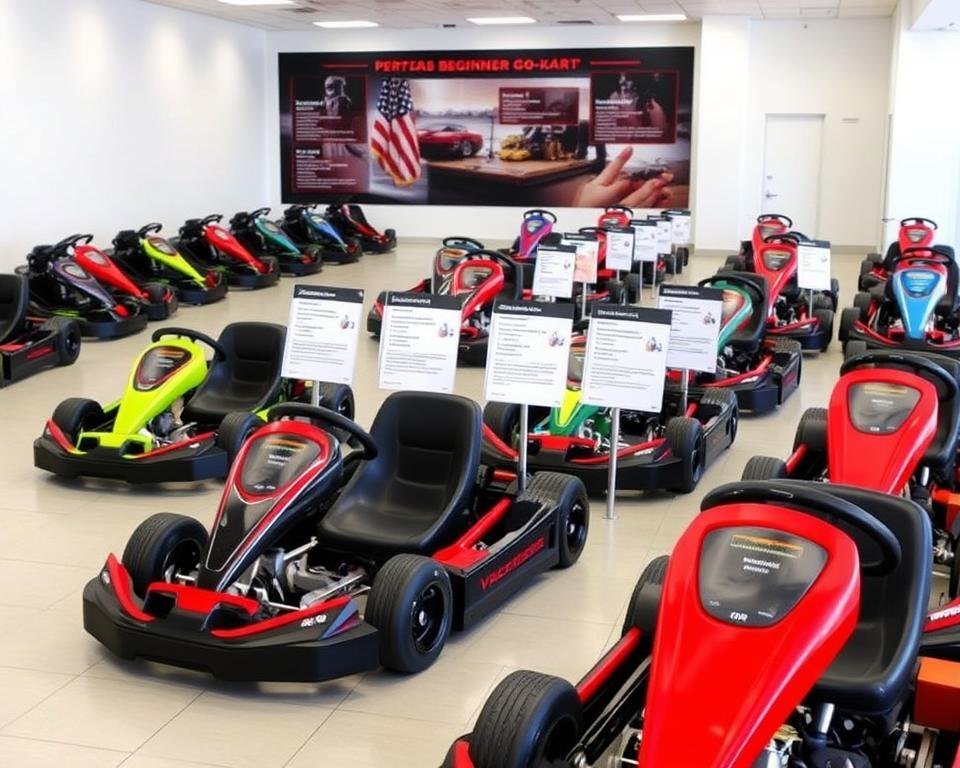Stepping into go-karting unlocks thrilling adventures while sharpening coordination and decision-making skills. Whether you’re eyeing weekend fun or future competitions, your first kart becomes the foundation for growth in this dynamic sport.
Safety and enjoyment go hand-in-hand when matching a vehicle to your needs. Recreational models differ from race-ready machines, and mixed-use options require extra scrutiny. Age, physical size, and driving goals all play critical roles in this decision.
Many new enthusiasts make costly errors by prioritizing speed over durability or underestimating maintenance needs. Our professional insights help you sidestep these pitfalls while staying within budget. You’ll learn why engine types, frame materials, and safety certifications matter more than flashy accessories.
This resource simplifies complex technical details into actionable advice. Discover how proper sizing enhances control during turns and why adjustable components extend a kart’s usability. With clear comparisons between electric and gas models, you’ll identify the best fit for local tracks or private property use.
By focusing on these essentials, you create safer learning conditions while maximizing the thrill of every ride. Let’s shift gears toward informed decisions that fuel your passion for years to come.
Understanding Go-Kart Types and Intended Use
Your karting experience hinges on matching equipment to objectives. Two primary categories dominate the market: casual-use models for family fun and precision-built machines for serious competition. This distinction impacts everything from engine power to maintenance requirements.
Recreational vs. Competitive Options
Casual karts prioritize safety and simplicity with engines under 10 horsepower. These models feature durable frames and basic suspension systems perfect for backyard tracks. Their affordability makes them popular for parents introducing kids to motorsports.
Competitive racing models demand specialized components like tuned exhausts and racing slicks. These karts require regular adjustments and cost 3-5 times more than recreational versions. Local track regulations often dictate specific chassis types and engine specs for sanctioned events.
Age and Skill Considerations
Manufacturers design karts for three age brackets. Bambino models (4-7 years) use speed limiters and padded seats. Cadet karts (7-12 years) introduce manual brakes and 60+ mph capabilities. Junior models (12+) mirror adult configurations with adjustable pedals.
Skill level determines when to upgrade components. Beginners benefit from fixed gear ratios, while advanced users need customizable setups. Always verify height/weight limits since proper fit prevents control issues during sharp turns.
How to Choose the Right Go-Kart for Beginners
Selecting your first kart shapes your entire motorsport journey. Focus on core features that balance safety with responsive handling. Engine type, braking efficiency, and adjustability directly impact your experience and long-term satisfaction.
Prioritize Safety and Adaptability
Electric models dominate entry-level options with instant acceleration and zero emissions. Their brushless motors require minimal upkeep compared to gas-powered models. Hydraulic disc brakes outperform mechanical systems during sudden stops, especially on uneven surfaces.
Adjustable seats and pedal positions accommodate growth spurts. Check weight limits and frame materials—steel chassis handle rough terrain better than aluminum. Reputable brands like Razor or Coleman include safety certifications in their specifications.
Align Components With Your Goals
Backyard tracks demand durable tires and suspension. Track-day models need racing slicks and tuned engines. Gas-powered karts suit longer sessions but require oil changes and carburetor checks.
Compare battery runtime against your typical drive duration. Lithium-ion packs recharge faster than lead-acid but cost more. Test-drive different performance levels to find your comfort zone without overwhelming new drivers.
Essential Safety Gear and Features
Safety forms the backbone of every successful karting session. Proper equipment and structural integrity work together to protect drivers during high-speed maneuvers. This protection starts with personal gear and extends to your kart’s built-in safeguards.

Must-Have Safety Gear
Certified helmets remain non-negotiable—look for Snell SA2020 or FIA 8860-2018 labels. Pair them with CIK-FIA approved race suits featuring multi-layer fire resistance. Kart-specific gloves improve grip while reinforced boots protect ankles during pedal work.
Neck braces and rib protectors add critical impact absorption. These components require professional fitting—ill-fitting gear compromises protection during collisions. Replace any equipment showing cracks or material degradation.
Structural and Component Inspections
Roll bars demand monthly checks for weld integrity and proper mounting. Test kill switches before each session—they must stop engines instantly. Hydraulic brakes need fluid level inspections, while mechanical systems require pad thickness evaluations.
Seat mounts and harness anchors require torque verification. Loose components create dangerous projectiles during crashes. Consider annual professional assessments to identify hidden stress points in frames.
Local Regulations and Safety Standards
Most U.S. tracks mandate ARKS licensing and SFI-certified gear. Some facilities prohibit certain chassis types or engine modifications. Always review venue-specific rules regarding fire extinguishers and safety flag protocols.
Documentation proves crucial—keep helmet certification stickers visible for inspections. Upgrade equipment every 3-5 years to match evolving safety benchmarks in motorsports.
Budgeting and Additional Costs
Smart financial planning separates fleeting hobbies from lasting motorsport commitments. Entry-level setups require $1,800-$7,000 upfront for the kart, safety gear, and transport. Annual costs escalate quickly—race entries and maintenance alone can hit $15,000.
Initial Investment and Hidden Expenses
Your budget must cover more than the kart’s price tag. Helmets and suits add $600-$2,000, while trailers range from basic $250 units to $12,000 enclosed models. Track fees and tire replacements often surprise new owners—factor in $3,000 yearly for regional competitions.
Toolkits and spare parts demand another $150-$500 initially. Club memberships and fuel costs vary by location but typically consume 20% of ongoing funds. Prioritize quality chassis and certified safety gear—they withstand wear better than cheaper alternatives.
Cost-Saving Tips and Long-Term Budgeting
Used karts from reputable sellers slash initial costs by 40-60%. Practice sessions benefit from secondhand tires, while DIY oil changes reduce mechanic fees. Package deals from retiring racers often include tools and spare components.
Allocate funds for unexpected repairs—worn chains and brake pads need frequent replacing. Invest in adjustable seats and pedals to accommodate growth, avoiding premature upgrades. Track your expenses monthly to identify savings opportunities without compromising safety.
Exploring Used Karts and Maintenance Essentials
Maximizing your kart’s lifespan requires careful selection and consistent care. Pre-owned models offer cost savings but demand thorough inspections and disciplined upkeep. Balancing initial affordability with long-term reliability separates savvy buyers from those facing endless repairs.
Evaluating Pre-Owned Karts
Inspect frames for cracks or bends near welds and mounting points. Worn steering columns and loose suspension arms signal neglect. Always review maintenance logs—frequent engine rebuilds or missing service records raise red flags.
Professional inspections verify critical components like brake calipers and axle alignment. Test-drive to assess vibration levels and steering responsiveness. These steps prevent costly surprises after purchase.
Routine Maintenance Schedules
Dedicate 30 minutes pre-race for tire pressure checks and chain lubrication. Post-session tasks include cleaning debris from wheel bearings and checking brake pad thickness. Weekly reviews should cover bolt tightness and fuel line integrity.
Monthly deep cleans prevent corrosion in critical areas. Budget $500-$1,500 annually for routine upkeep plus an emergency fund. Consistent care reduces breakdowns during crucial track days.
Spare Parts and Troubleshooting Basics
Stock essential spares: spark plugs, clutch springs, and master links. Engine issues often stem from fouled plugs or stale fuel—keep diagnostics simple. Brake failures usually trace to worn pads or contaminated fluid.
Track component replacements in a maintenance log. This practice helps identify wear patterns and maintains warranty compliance. Basic mechanical skills let you address 80% of common issues without professional help.
Expert Tips for Go-Kart Performance and Upgrades
Elevating your kart’s capabilities demands both technical know-how and strategic enhancements. Precision adjustments and compliant modifications create measurable improvements while preserving reliability. Start with foundational tuning before exploring advanced upgrades.
Performance Tuning and Adjustments
Steering geometry makes or breaks cornering efficiency. Set toe-in between 1/16″ to 1/8″ for responsive handling without excessive tire wear. Chain tension requires weekly checks—a properly adjusted drive chain should deflect ½ inch when pressed.
Carburetor optimization separates casual drivers from competitive racers. Adjust air-fuel mixtures based on track altitude and temperature. For IAME Gazelle engines, maintain 12,500 RPM limits. Rotax Max users should monitor exhaust gas temperatures during tuning sessions.
Upgrading and Customization Considerations
Prioritize weight distribution upgrades before chasing raw power. Moving seat positions ½ inch alters balance more than adding 2 horsepower. Electric go-karts benefit from programmable controllers that adjust torque delivery per track conditions.
Always verify class regulations before installing performance parts. Racing slicks work wonders on sealed tracks but violate some junior series rules. Document every modification’s impact through timed laps to identify truly effective changes.
Conclusion
Your journey into motorsports begins with a smart initial investment. Finding that perfect go-kart requires balancing practical needs with future aspirations. Focus on models matching your primary use case while allowing room for skill development.
Prioritize adaptable designs that grow with young drivers. Adjustable seats and safety-certified frames ensure lasting value. For kids and adults alike, proper sizing directly impacts control during high-speed maneuvers.
Quality components deliver consistent performance across countless rides. Whether upgrading tires or maintaining engines, each decision shapes your overall experience. Remember—the right choice amplifies enjoyment while minimizing unnecessary risks.
Now equipped with essential insights, you’re ready to select your first go-kart confidently. Apply these principles to navigate local track rules and budget considerations effortlessly. Every thrilling ride becomes safer and more rewarding when fundamentals align with your goals.
Let this knowledge fuel countless hours of fun while building skills that last. The perfect kart awaits—time to start your engines.

